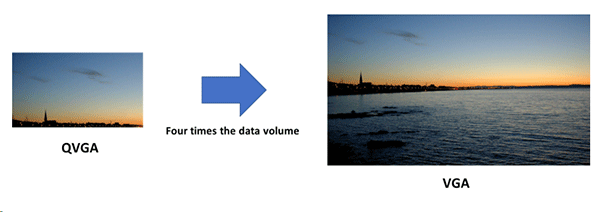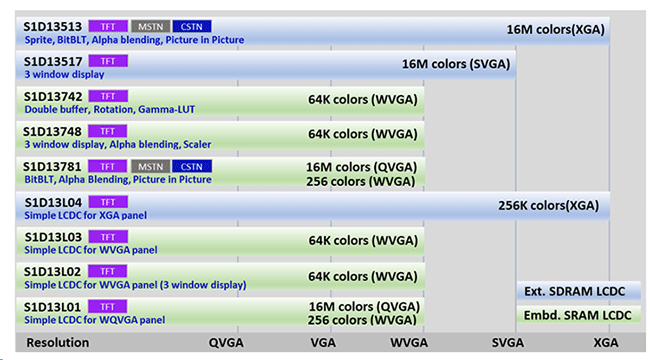What is an LCD Controller (LCD display controller)?
An LCD controller (Liquid Crystal Display Controller) is a specialized integrated circuit (IC) that connects to a host CPU and controls the LCD panel. It is also known as an LCDC (LCD Controller), display controller, or liquid crystal controller. Hereafter, we will refer to it as LCDC.
The LCDC receives display image data from the host CPU and outputs the data and synchronization signals at timings that match the specifications of the LCD panel. Some LCDCs come with built-in memory and image processing functions, allowing them to expand, shrink, rotate, or overlay multiple images to fit the display screen size.
What is an LCD control board (Display controller board)?
LCD control board, in other words “Screen controller board” or “Monitor controller board” is a board equipped with LCD controller and connectors which can be connected to CPU and LCD panel.
Here we explain about examples of Epson LCDC evaluation boards to be used with Arduino board.
Arduino is a widely sold board equipped with an MCU. Here, we introduce an example of using the Arduino Due, one of the Arduino boards, connected to Epson's LCDC S1D13781.
The Arduino Due is a board that features the Atmel SAM3X8E, which is based on the ARM Cortex-M3 core. While it is sold worldwide, it is also readily available through many online retailers.
The S1D13781 is an LCDC capable of full-color display control up to WQVGA. The S5U13781R01C100 board is equipped with the S1D13781 and is designed for easy connection to the Arduino Due.
We have prepared a reference design that combines the S5U13781R01C100 board, the Arduino Due, and a WQVGA TFT LCD module, allowing you to easily verify the functionality of the LCDC. For more details, please refer to the URL below.

What is an LCD driver (LCD display driver)?
An LCD driver is an IC that stores display data transferred from a microcontroller and drives the LCD panel. Epson LCD drivers, with built-in RAM, enable LCD display with ultra-low power consumption.
URL:https://global.epson.com/products_and_drivers/semicon/products/lcd_drivers/
Overview of Epson LCD Controllers
Features of Epson Controllers
Epson LCDC reduces load of host CPU and realizes both of low power consumption and high speed image drawing by its unique image processing unit. Epson LCDC line ups various type of display controllers such as memory display, STN and TFT for broad application.
Detailed features
URL:https://global.epson.com/products_and_drivers/semicon/products/display_controllers/contents.html
The main applications of Epson LCDC
Epson's LCDC covers the main resolutions of TFT LCD modules, particularly used in industrial applications. Adding Epson's LCDC as an addon to the host (CPU) efficiently achieves color display in a short period of development time.

To convert a monochrome TFT display to color
Converting a monochrome TFT display to color involves several considerations. Primarily, it requires an increase in the amount of data necessary for display, as well as higher memory capacity and hardware performance for processing.
For instance, with a monochrome QVGA (320x240 pixels, 16 shades of gray) panel, the data capacity for a single image is calculated as follows: 320x240x4 bits = 76,800x4 bytes = 38,400 bytes. In contrast, a full-color QVGA panel (16 million colors, each RGB channel 8 bits) would require: 320x240x24 bits = 76,800x24 bits = 230,400 bytes, which is six times more data compared to monochrome. The processing and memory requirements for handling and transferring image data are significantly different between monochrome and color displays.
If the CPU lacks the necessary specifications, replacing the entire CPU may become necessary, leading to considerable effort and cost. However, introducing an Epson LCD controller enables colorization without requiring a CPU replacement, leveraging existing hardware effectively.

When TFT is upgraded to high resolution
Let's consider the scenario of upgrading the resolution of a color TFT LCD from QVGA to VGA (640x480 pixels). For a full-color QVGA panel, as mentioned earlier, the data size for one image is 230,400 bytes. Similarly, for a WVGA panel:640x480x24 bits = 307,200x24 bits = 921,600 bytes
This means that WVGA requires four times the data capacity compared to QVGA. Increasing the display resolution also increases the required memory capacity and processing requirements, similar to the challenges faced when transitioning from monochrome to color.
In both cases—whether converting to color or upgrading to higher resolution—introducing an Epson LCD controller allows for achieving these enhancements without the need to replace the existing CPU. This approach effectively manages the increased demands in memory capacity and performance while utilizing the current hardware setup.

The types of Epson LCD controllers
SRAM Integrated Products
These products include built-in memory (up to 1024KB) and support LCD displays with resolutions up to WVGA (480x800).
External SDRAM Integrated Products
Products supporting high-resolution displays up to XGA (1024x768) require external memory for operation.
Simple LCDC
This product line features basic functions of an LCDC, designed for low cost and low power consumption.

Product selector
Epson offers a wide variety of LCD controllers. To select the best display controller for your intended application, please consult with LCDC Product Selector page on Epson web site.
